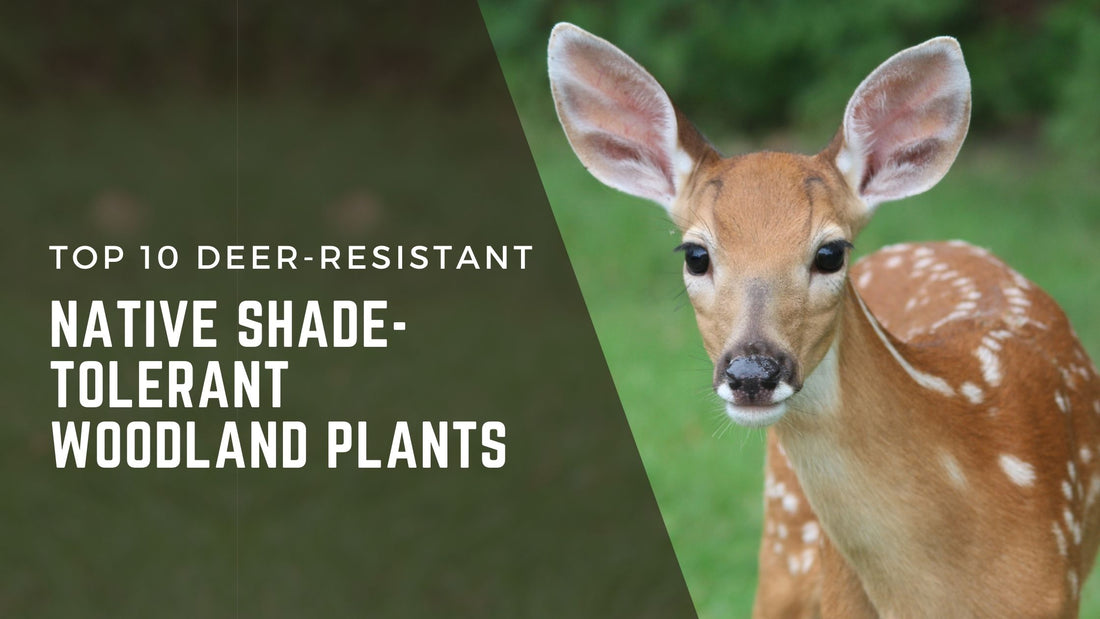Got a shady backyard that’s overrun by deer? You’re not alone. Shady areas can be tricky to plant, especially when deer treat your garden like their personal salad bar. But there’s good news—there are plenty of deer-resistant native plants that thrive in shady conditions and add stunning beauty to your landscape.
Across the Midwest, oak woodlands are vanishing at alarming rates. In the Chicago area alone, over 80% of these critical ecosystems have disappeared, leading to declines in plants, animals, and insects. Invasive species and booming deer populations have only worsened the problem. However, planting native shade-tolerant plants can help rebuild biodiversity, whether you’re restoring a backyard or a full oak woodland.
Below are 10 deer-resistant woodland plants that are perfect for shady Midwest gardens.
1. Virginia Bluebells (Mertensia virginica)
Virginia Bluebells are one of the most iconic native woodland flowers. These spring-blooming perennials produce clusters of delicate blue flowers that attract early-season pollinators like bees and butterflies, including the endangered Rusty Patch Bumble Bee.
- Benefits: Deer-resistant, perennial, adaptable to various soil types
- Best for: Shaded gardens, native woodland restoration
2. Pennsylvania Sedge (Carex pensylvanica)
This versatile native groundcover for shade is a low-maintenance, deer-resistant option that prevents soil erosion. Pennsylvania Sedge improves soil health by adding organic matter and supports beneficial insects vital to oak woodlands.
- Benefits: Dense groundcover, supports oak ecosystems, prevents erosion
- Best for: Woodland edges, shaded slopes, beneath oak trees
3. Spring Beauties (Claytonia virginica)
Spring Beauties carpet shady areas with delicate white flowers streaked in pink. These perennials are early bloomers, making them essential nectar sources for pollinators like specialist Andrena bees. Once they mature, Spring Beauties slowly spread through their roots and seeds, and when they're well established, they can carpet the woodland floor in a glorious show of flowers.
- Benefits: Deer-resistant, supports pollinators, spreads easily
- Best for: Naturalizing shady woodland floors
4. Wild Ginger (Asarum canadense)
Wild Ginger’s heart-shaped leaves form a lush, deer-resistant groundcover for shaded gardens. It’s also fascinating for its seed dispersal strategy—ants carry the seeds, helping the plant spread to suitable spots in your garden.
- Benefits: Low-maintenance groundcover, supports wildlife, shade-loving
- Best for: Woodland groundcovers, shaded borders
5. Bluestem Goldenrod (Solidago caesia)
For late-season blooms in the shade, Bluestem Goldenrod is a standout. Its golden-yellow flowers provide nectar for pollinators when other food sources decline, making it a critical plant for late summer and fall.
- Benefits: Supports bees and butterflies, deer-resistant, late-season blooms
- Best for: Shady woodland edges, pollinator gardens
6. Mayapples (Podophyllum peltatum)
Mayapples are instantly recognizable with their umbrella-like leaves. While their ripe fruit is edible, all other parts of the plant are toxic. These shade-loving perennials provide shelter for small wildlife and food for early-season pollinators.
- Benefits: Unique foliage, deer-resistant, wildlife-friendly
- Best for: Woodland understories, shaded landscapes
7. Jack-in-the-Pulpit (Arisaema triphyllum)
Jack-in-the-Pulpit is an exotic-looking woodland plant with a hooded flower structure that thrives in moist, shaded soil. Its intriguing design and deer resistance make it a showstopper in shady gardens.
- Benefits: Unique blooms, shade-loving, deer-resistant
- Best for: Moist woodland gardens, shady borders
8. Curly Wood Sedge (Carex rosea)
Curly Wood Sedge adds soft texture to shady areas with its delicate, light-green foliage. It stabilizes soil, provides cover for wildlife, and improves moisture retention in woodland ecosystems.
- Benefits: Erosion control, wildlife habitat, low-maintenance
- Best for: Shade groundcovers, stabilizing slopes
9. Ostrich Fern (Matteuccia struthiopteris)
Ostrich Ferns bring bold texture to shady gardens with their feathery fronds. They thrive in rich, moist soil and spread naturally, making them perfect for filling larger shady spaces.
- Benefits: Hardy, erosion control, wildlife cover
- Best for: Moist woodland areas, shady garden backdrops
10. Bottlebrush Grass (Elymus hystrix)
Bottlebrush Grass is a unique, low-maintenance grass ideal for partial to full shade. Its seed heads resemble bottlebrushes and provide habitat and food for wildlife, including birds and butterflies.
- Benefits: Deer-resistant, visually interesting, wildlife-friendly
- Best for: Shaded meadows, woodland borders
Why Plant Native Shade-Tolerant Plants?
By choosing deer-resistant native plants, you’re restoring natural habitats, supporting pollinators, and protecting your garden from deer damage. Whether you’re in the Midwest or beyond, these plants add biodiversity and beauty to your shady spaces.
Ready to transform your shady backyard into a thriving native woodland? Start with these easy-to-grow, deer-resistant perennials.

